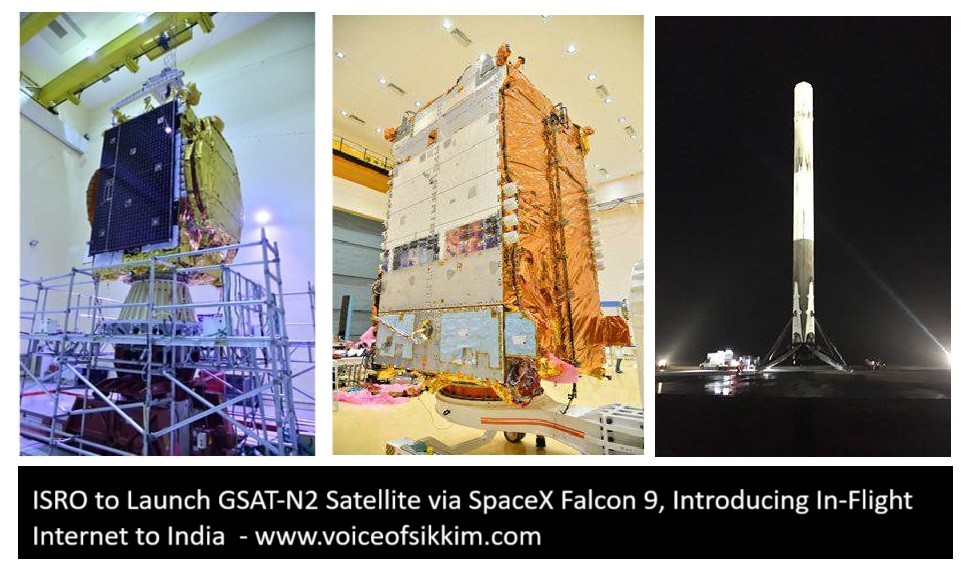
The Indian Space Research Organisation (ISRO) is preparing to launch its latest communication satellite, GSAT-N2, aboard SpaceX’s Falcon 9 rocket. This marks a significant milestone as the satellite will provide in-flight internet access, making India one of the latest countries to offer such services.
The GSAT-N2 satellite, also known as GSAT-20, weighs 4,700 kg—too heavy for ISRO’s current fleet of rockets. To facilitate its deployment, ISRO has partnered with SpaceX, using its heavy-lift Falcon 9 rocket. Although developed by ISRO, the mission is managed under its commercial arm, New Space India Limited (NSIL). Beyond in-flight internet, GSAT-N2 will also enable broadband services in remote areas of India.
This launch will be ISRO’s first commercial collaboration with SpaceX, a move that highlights its commitment to leveraging global partnerships for technological advancement.
Technical Capabilities of GSAT-N2
GSAT-N2 is a Ka-band high-throughput satellite (HTS), specifically designed to enhance broadband and in-flight connectivity across India. Its innovative multi-beam architecture includes 32 user beams: 8 narrow spot beams focused on the Northeast and 24 wide spot beams covering the rest of India. These beams are supported by hub stations located within the mainland, providing a total throughput of approximately 48 Gbps.
The satellite features three 2.5-meter deployable reflectors with multiple feeds, optimizing frequency reuse and increasing system capacity. Its mission life is expected to be 14 years, during which it will play a critical role in supporting a growing subscriber base with small user terminals.
“This satellite will bridge the gap in India’s in-flight internet services, finally putting us on the global connectivity map,” said Dr. M. Sankaran, Director of the UR Rao Satellite Centre in Bengaluru. “GSAT-N2 is India’s highest-throughput satellite and the only one dedicated to the Ka-band,” he added.
Regulatory Developments and Service Implementation
Currently, in-flight internet is unavailable in India due to regulatory restrictions. However, recent amendments now permit Wi-Fi services on aircraft once they reach an altitude of 3,000 meters. This change aligns India with international standards, ensuring uninterrupted connectivity for passengers during flights.
The government has also clarified that internet services can only be used when electronic devices are allowed onboard. To prevent interference with terrestrial networks, service providers must operate at the stipulated altitude, as outlined in the Flight and Maritime Connectivity Rules, 2018.
Despite the imminent launch, in-flight internet services won’t be available immediately. Airlines must first acquire necessary licenses and install onboard equipment to facilitate the service.
Collaboration with Viasat and BSNL
American satellite communication firm Viasat has announced plans to utilize GSAT-N2 for both in-flight and maritime connectivity in India. The company, in partnership with BSNL, is also working to launch Direct-to-Device satellite services, further enhancing India’s digital infrastructure.
Previous Falcon 9 Missions
This isn’t the first time ISRO has collaborated with SpaceX. Earlier this year, a Falcon 9 rocket successfully launched a military-grade satellite for Tata, underlining the growing trust and cooperation between Indian entities and SpaceX.
The launch of GSAT-N2 represents a pivotal step in transforming India’s communication landscape, offering high-speed internet access in previously unconnected regions and enabling seamless connectivity for air travelers.
Why ISRO is Relying on SpaceX to Launch the GSAT-N2 Satellite
India’s GSAT-N2 (also known as GSAT-20) communications satellite is set to be launched by Elon Musk’s SpaceX, highlighting a strategic collaboration between the Indian Space Research Organisation (ISRO) and the American aerospace giant. Scheduled for November 19, 2024, the launch will take place from Cape Canaveral, Florida, aboard a SpaceX Falcon 9 rocket.
Why SpaceX?
The decision to partner with SpaceX stems from GSAT-N2’s significant weight—4,700 kg—making it too heavy for ISRO’s current launch capabilities. ISRO’s heaviest launcher, the LVM-3, can handle payloads up to 4,000 kg in Geosynchronous Transfer Orbit (GTO). Given this limitation, ISRO had to look beyond its own fleet to ensure the successful deployment of the satellite.
GSAT-N2: Enhancing India’s Communication Infrastructure
Once operational, GSAT-N2 will play a critical role in improving India’s communications network. The satellite carries a Ka-band high-throughput communications payload with a 14-year mission lifespan. It will provide services such as internet connectivity in remote areas and in-flight internet access, a feature recently greenlit by Indian regulators.
The satellite’s advanced design includes 32 user beams, comprising eight narrow spot beams and 24 wide spot beams, supported by hub stations across India. These capabilities are expected to revolutionize connectivity, especially in underserved regions.
Why Not Traditional Partners?
Historically, ISRO has relied on European launch provider Arianespace for heavy satellite missions. However, with Arianespace facing operational setbacks and geopolitical tensions limiting access to Russian and Chinese launch vehicles, SpaceX emerged as the optimal choice. This launch marks ISRO’s first commercial collaboration with SpaceX, setting a precedent for future partnerships.
Broader Implications for Space Collaboration
This collaboration signals more than just a logistical solution—it reflects the evolving dynamics of global space exploration. By teaming up with SpaceX, ISRO leverages cutting-edge launch technology while expanding its own satellite capabilities.
Interestingly, this partnership also ties into India’s broader ambitions in human spaceflight. Group Captain Shubhanshu Shukla is undergoing training with Axiom Space for a 2025 mission to the International Space Station (ISS). Although SpaceX is not directly training him, its Dragon spacecraft will be used for the mission, demonstrating the interconnectedness of these programs.
Conclusion
As India continues to advance its space ambitions, partnerships with global players like SpaceX are becoming increasingly essential. The GSAT-N2 mission is a testament to ISRO’s pragmatic approach in leveraging international expertise to meet the growing demand for high-capacity communication services.






